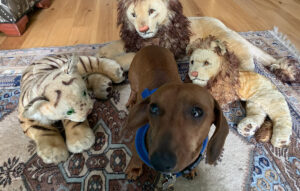 Steiff Toys take me back to a little Midwestern redbrick house in 1960s Deerfield Illinois. A burly gentleman who didn’t speak English carried a four-foot-long walrus with a blue bow around its neck. That stranger, my mom’s cousin from Germany, brought me this walrus from Steiff, a famous German maker of mohair animals. I still have the walrus and many more Stieff animals, as most of Mom’s relatives came from Germany bearing gifts made by Steiff.
Steiff Toys take me back to a little Midwestern redbrick house in 1960s Deerfield Illinois. A burly gentleman who didn’t speak English carried a four-foot-long walrus with a blue bow around its neck. That stranger, my mom’s cousin from Germany, brought me this walrus from Steiff, a famous German maker of mohair animals. I still have the walrus and many more Stieff animals, as most of Mom’s relatives came from Germany bearing gifts made by Steiff.
Passing a yard sale recently, I saw a much loved recumbent Steiff ‘Leo’ Lion in mohair from the 1960s with amber glass eyes and the intact button and ear tag. It stretches thirty-six inches with a long tan and brown mane and tail, embroidered nose, mouth, and paws. Two Steiff friends came with him: a fifteen-inch-long recumbent lion and a two-foot striped (airbrushed) tiger. I bought all three. One of my grandchildren will have the whole collection of mine foisted upon them soon!
Margarete Steiff Founded the Company
Female entrepreneur, Margarete Steiff, founded the Company in 1877. Her motto was “Freedom is believing in yourself.” On the company Website “Die Welt von Steiff” (the world of, or according to, Steiff), her history is elucidated. Born in 1847, at eighteen months she developed polio which dogged her her whole life. In 1877 she opened a felt clothing shop and made small felt elephants (Elefantle) pincushions, which became a popular kid’s toy. She hired ten seamstresses and made small monkeys, donkeys, horses, camels, pigs, mice, dogs, cats, rabbits, and giraffes. All these soft felt toys became sought after. In 1893 the Leipzig Toy Fair asked her to show her “Filzspielwarenfabrik” goods. Harrods in London noticed her work, and commissioned felt toys in 1895.
As she got older, and famous, her favorite creative nephew joined her company in 1897 after studying design at the School of Applied Arts in England. Richard Steiff is credited with the design that made Steiff Toys famous: the cuddly bear. In 1902 the bear came with movable arms and legs, made of mohair, the fabric discovered at the Leipzig Toy Fair on another dealer’s bear. Richard jointed the arms and legs at first with string, then rods, and in 1905, he invented disk joints, still used today. An American company noticed the Steiff bear and ordered 3,000 on the spot. Since Richard “borrowed’ the idea of a mohair bear body, he made a metal button for each toy labelled “Steiff” as a protection against such “borrowing.”
Teddy Bear
The bear became the Teddy Bear in 1906 when President Theodore Roosevelt refused to shoot a bear on a leash during a hunt. When the newspapers carried the story and the illustration, Steiff bears flew off shelves branded as Teddy Bears.
Three years after the Teddy bear boom began, Margarete died of pneumonia. She’d witnessed incredible success. That continued under her nephew, who in 1931 formed a partnership with Walt Disney. Cartoon characters entered the Steiff oeuvre, created by a staff of 2,000 workers in ultra-modern Bauhaus style glass factories.
If you had German relatives like me in the 1960s, they might have gifted you a Hedgehog “Mecki,” synonymous with German-ness in his Lederhosen and hunter cap. Another famous “animal” for Steiff!
100th Year of Stieff History
In 1980 a Steiff Museum opened in Germany producing limited edition stuffed toys. It also featured a Disney style theme park with a gigantic snake slide, a petting zoo, and a children’s ride on life sized Steiff tigers, elephants, camels, and gorillas. Icon of fashion, Karl Lagerfeld, was commissioned to design a line of stuffed toys all wearing his signature dark sunglasses. A high priced Louis Vuitton bear was designed in Paris. Finally, in 2020, Margarete, who would’ve been 140, was inducted into the Toy Industry’s Hall of Fame as the Steiff bear turned 120 years.
My newly adopted lions and one tiger are worth $300 for the set. If the condition of the mohair were better, they would be worth far more. Of course, Steiff toys like other toys come scarce in excellent or original condition because kids played with them. A Korean collector paid the highest price ever paid for a bear, €213,720, in 2000. The highest auction sale was for a 1912 bear at Christie’s for €150,212.